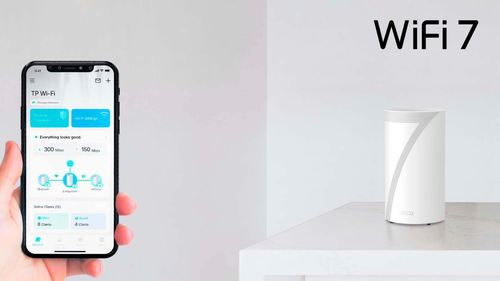Ad

Revolutionize Your Home Connectivity with TP-Link's Wi-Fi 7 Routers
Follow Us:
5,631 views
Unleash Unprecedented Performance: While Wi-Fi 6 served as a transitional generation with notable stability improvements, Wi-Fi 7 takes a giant leap forward in terms of speed. With the potential to reach speeds of up to 46 Gbps, Wi-Fi 7 offers a significant performance boost, surpassing its predecessor, Wi-Fi 5, by 4.8 times.
Multi-Frequency Bands: Wi-Fi 7 operates on three frequency bands: 2.4 GHz, 5 GHz, and 6 GHz. Devices seamlessly switch between these bands to deliver optimal performance in different situations. The 2.4 GHz band excels in providing coverage over longer distances, while the 5 GHz and 6 GHz bands prioritize high-speed connections over shorter ranges.
Wi-Fi 7 introduces wider channel sizes of up to 320 MHz in the 6 GHz band, mitigating the effects of channel congestion and overload. This increased channel width allows for faster data transmission to and from multiple devices simultaneously, significantly boosting network capacity by up to five times compared to Wi-Fi 6.
Enhanced Stability and Lower Latency: Building upon the success of previous standards, Wi-Fi 7 incorporates 16x16 MU-MIMO technology, doubling the number of spatial streams compared to Wi-Fi 6. This ensures sufficient bandwidth allocation for all devices in the home, even during simultaneous usage.
The modulation scheme of Wi-Fi 7 has also been improved. With 4096-QAM (Quadrature Amplitude Modulation), each symbol can carry 12 bits of information, making it around 20% more efficient than the 1024-QAM of Wi-Fi 6. The higher transmission rate reduces latency, particularly beneficial for online gaming and streaming 4K or 8K videos, minimizing buffering.

Introducing Multi-RU and Multi-Link Operation: Wi-Fi 7 introduces Multi-RU, which assigns multiple resource units (RU) to a single user, improving spectral efficiency and transmission performance. In contrast, Wi-Fi 6 only allows one resource unit per user, even if additional RUs are available.
Multi-Link Operation is another notable feature of Wi-Fi 7, enabling devices to send and receive data simultaneously on different frequency bands and channels. This results in increased speeds, reduced latency, and enhanced reliability for applications like augmented and virtual reality, cloud computing, online gaming, and more. The First Wi-Fi 7 Routers: TP-Link takes the lead in bringing the benefits of Wi-Fi 7 to consumers with their Mesh systems. The TP-Link Deco BE65 offers mesh Wi-Fi coverage up to 725 m², providing excellent connectivity even in larger homes. With speeds reaching up to 9 Gbps, distributed across the 6 GHz, 5 GHz, and 2.4 GHz bands, the Deco BE65 ensures a seamless online experience. It includes four 2.5 Gbps Ethernet ports for enhanced stability.
For those seeking a high-end option, the TP-Link Deco BE85 Mesh system delivers exceptional performance. With speeds of up to 19 Gbps and coverage of up to 1400 m², this tri-band
Latest News





Reviews & Guides
View All

Nothing Phone 3a Community Edition First Impressions: A Fresh Take on Budget Smartphones

Realme P4x 5G Review: Budget-Friendly Beast with Epic Battery Life

Sony BRAVIA 7 Mini LED K-65XR70 vs. Haier Mini LED H65M95EUX

Samsung QN90F (65QN90FAU) Review: The King of Bright-Room Viewing

Why doesn’t Apple reveal the iPhone battery in advertisements?

Top 10 camera lenses you should Own in 2025

Donald Trump Watch Collection: Timeless Luxury on the Wrist

Best Smartphones Under 30,000 in 2025







